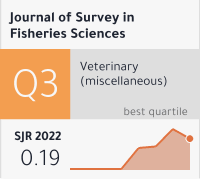Prevalence and Characteristics of Gastrointestinal Parasites in Backyard Chickens of Khuzdar, Baluchistan
DOI:
https://doi.org/10.53555/sfs.v11i4.2742Keywords:
Prevalence, Helminths, Gender Differences, Age Groups, Ascaridia gallAbstract
The prevalence, severity, and diversity of gastrointestinal parasites in backyard chickens in Khuzdar, Baluchistan. A total of 200 fecal samples (100 males and 100 females) were collected. During sample collection, a thorough physical examination was conducted, noting parameters such as consistency, color, odor, and any abnormalities. The samples were carefully maintained under cold chain conditions and transported to the Department of Veterinary Parasitology at the Faculty of Animal Husbandry & Veterinary Sciences for further analysis. Microscopic examination of the fecal samples focused on identifying helminths. Various techniques, including the direct smear method, floatation method, and sedimentation method, were employed to detect helminth eggs. The results revealed that 53.50% of the fecal samples tested positive for eggs of different gastrointestinal parasites. Among the study areas, the highest prevalence rate (66.00%) was observed in Tehsil Zehri, followed by Karakh (54.00%), Wadh (50.00%), and Naal (44.00%). Gender differences were significant, with female backyard chickens being more susceptible to helminthic infection (72.00%) compared to males (35.00%). However, no statistically significant difference was found in the age groups of the chickens (p>0.005). Among age groups, gastrointestinal parasite infection was highest (56.00%) in chickens above sixteen weeks, followed by 53.00% in the 0-6 weeks group and 52.00% in the 6-15 weeks group.High (>1500 EPG),Medium (500-1000 EPG),Low (<500 EPG) medium load areas had the highest severity burden of helminth infection (48.59%). Ascaridia galli ,54.20%)Raillietina tetragona :24.29%) and Raillietina cesticillus : 21.49%)The highest prevalence occurs in Tehsil Zehri, and female hens are more susceptible to helminthic infection. Older chickens exhibit higher infection rates. Notably, Ascaridia galli is the most prevalent species in the region.









